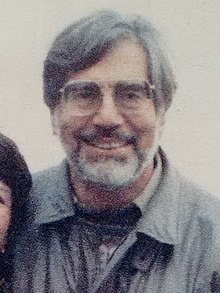Cinna Lomnitz
Cinna Lomnitz | |
|---|---|
 | |
| Born | 4 May 1925 Cologne, Germany |
| Died | 7 July 2016 (aged 91) Mexico City, Mexico |
| Nationality | Chilean Mexican |
| Alma mater | University of Chile |
| Known for | Lomnitz law |
| Relatives | Claudio Lomnitz |
| Scientific career | |
| Fields | Seismology, geophysics, rock mechanics |
| Institutions | National Autonomous University of Mexico University of California, Berkeley University of Chile |
Cinna Lomnitz Aronsfrau (4 May 1925 – 7 July 2016) was a Chilean-Mexican geophysicist known for his contributions in the fields of rock mechanics and seismology.
Early life and education[]
Lomnitz was born to a Jewish family in Cologne, Germany.[1] He graduated as engineer from the University of Chile in 1948. He then studied with Karl von Terzaghi in Harvard University and obtained a Master's degree in soil mechanics.[2]
Lomnitz received his doctorate from Caltech in 1955 with a dissertation on creep measurements in igneous rocks.[3] Its principal thesis, a logarithmic creep behavior observed in rocks, was reformulated as the "Lomnitz Law" by Harold Jeffreys in 1958.[4] The Lomnitz law is expressed as,
Career[]
Lomnitz was the founding director of the Instituto de Geofísica at the Universidad de Chile. He then taught at the University of California-Berkeley between 1964 and 1968, and moved to the Universidad Nacional Autónoma de México's Instituto de Geofísica in 1968, where he worked for the rest of his life. He founded Mexico's first seismic network, RESMAC, in 1971, and became editor of the journal Geofísica Internacional in 1990. Lomnitz authored a number of books, notably Global Tectonics and Earthquake Risk (Elsevier, 1974).[citation needed]
Personal life[]
He married the social anthropologist, Larissa Adler Lomnitz, and they were the parents of Jorge Lomnitz (1954-1993), Claudio Lomnitz, Alberto Lomnitz and Tania Lomnitz.[6] Cinna Lomnitz died in Mexico City in 2016 at the age of 91.[7]
References[]
- ^ Cinna Lomnitz Aronsfrau profile, 100.unam.mx; accessed 11 July 2016.(in Spanish)
- ^ Urrutia Fucugauchi, Jaime (8 August 2012). "Cinna Lomnitz, sismólogo. La ley de la deformación de las rocas lleva su nombre". Judíos Destacados en México. Diario Judío (in Spanish). Archived from the original on 16 January 2013. Retrieved 21 February 2013.
- ^ Lomnitz, C. (1956). "Creep Measurements in Igneous Rocks". The Journal of Geology. 64 (5): 473–479. doi:10.1086/626379. ISSN 0022-1376. JSTOR 30057041.
- ^ Jeffreys, Harold; Crampin, Stuart (1960-12-01). "Rock Creep: A Correction". Monthly Notices of the Royal Astronomical Society. 121 (6): 571–577. doi:10.1093/mnras/121.6.571. ISSN 0035-8711.
- ^ Jump up to: a b c Pandey, Vikash; Holm, Sverre (2016-09-23). "Linking the fractional derivative and the Lomnitz creep law to non-Newtonian time-varying viscosity". Physical Review E. 94 (3): 032606. doi:10.1103/PhysRevE.94.032606. PMID 27739858.
- ^ Lomnitz, Larissa Adler de (1998). Cómo sobreviven los marginados. Siglo XXI. pp. 13–. ISBN 968-23-1565-4.
- ^ "Muere Cinna Lomnitz, el geofísico más importante de AL". Jornada.unam.mx. Archived from the original on 9 July 2016. Retrieved 8 July 2016.
- 1925 births
- 2016 deaths
- Chilean geophysicists
- Mexican geophysicists
- Harvard University alumni
- Jewish engineers
- Jewish physicists
- Members of the Chilean Academy of Sciences
- Members of the Mexican Academy of Sciences
- Naturalized citizens of Mexico
- Chilean emigrants to Mexico
- Scientists from Cologne
- Seismologists
- University of Chile alumni
- University of Chile faculty
- Jewish emigrants from Nazi Germany to Chile
- 20th-century physicists
- 21st-century Mexican physicists
- Chilean expatriates in the United States
- Mexican scientist stubs
- Chilean people stubs
- South American scientist stubs

![{\displaystyle \varepsilon \left(t\right)={\frac {\sigma }{E_{0}}}\left[1+q\ln \left(1+at\right)\right],{\text{ }}t\geq 0,}](https://wikimedia.org/api/rest_v1/media/math/render/svg/55e66f3ff04f6703ab239859343fedd21c913bd4)














